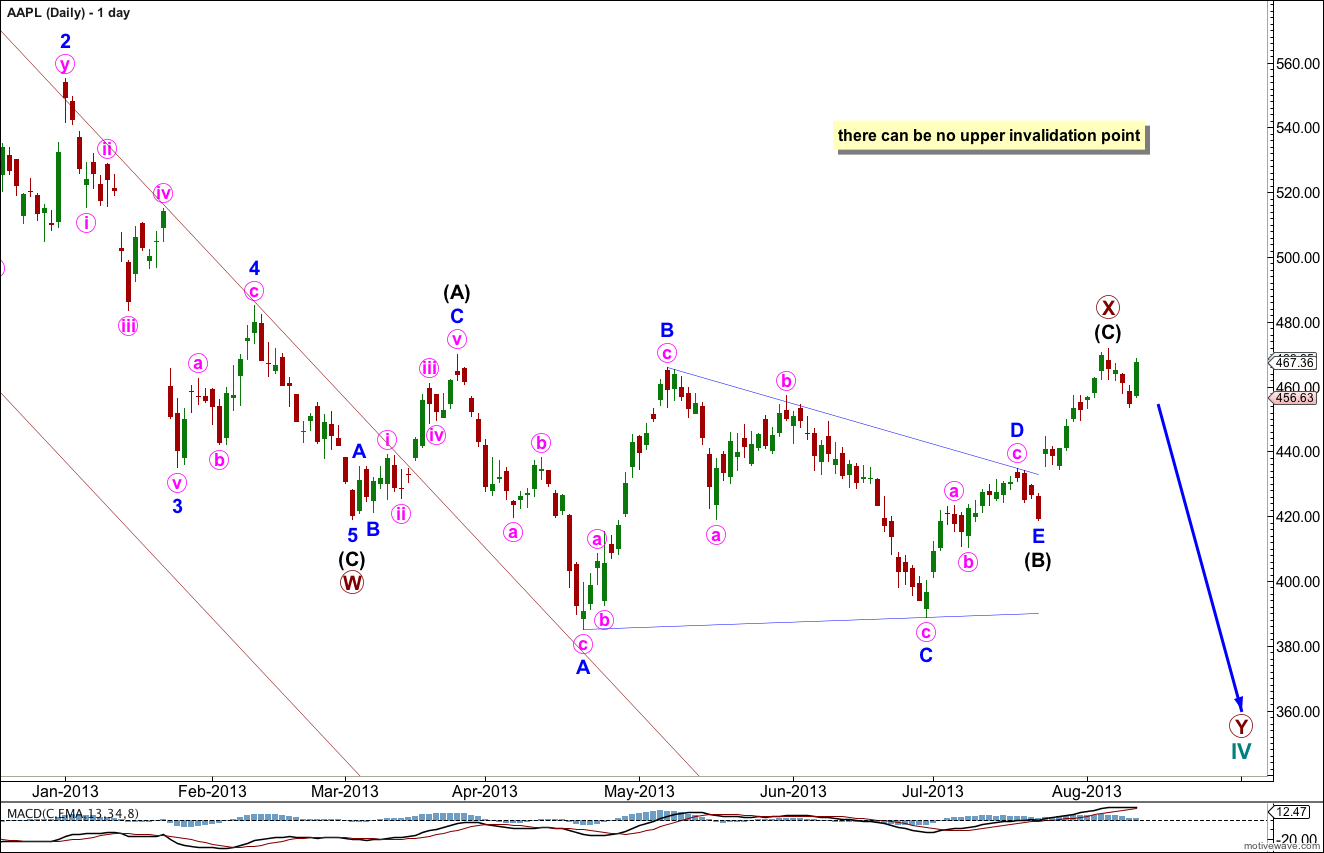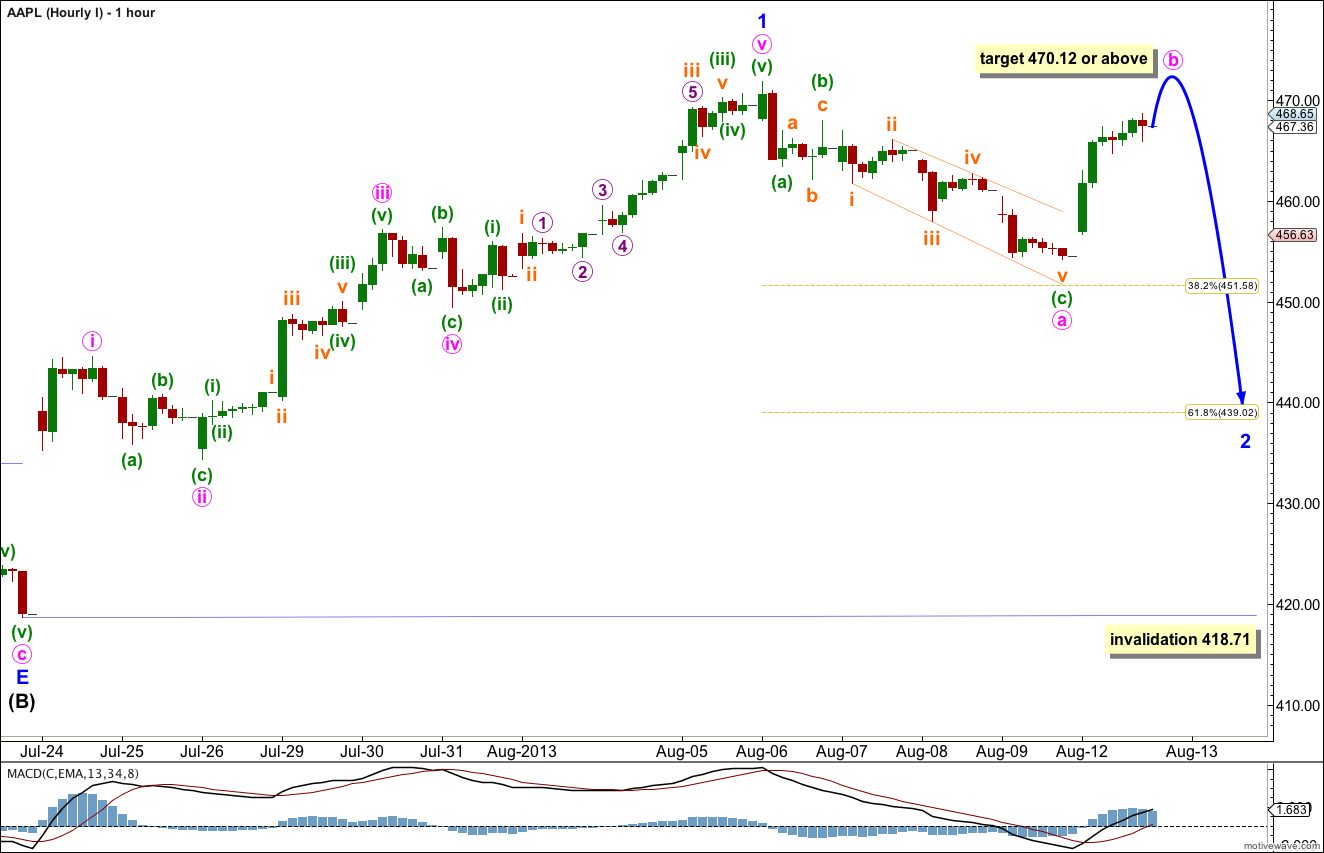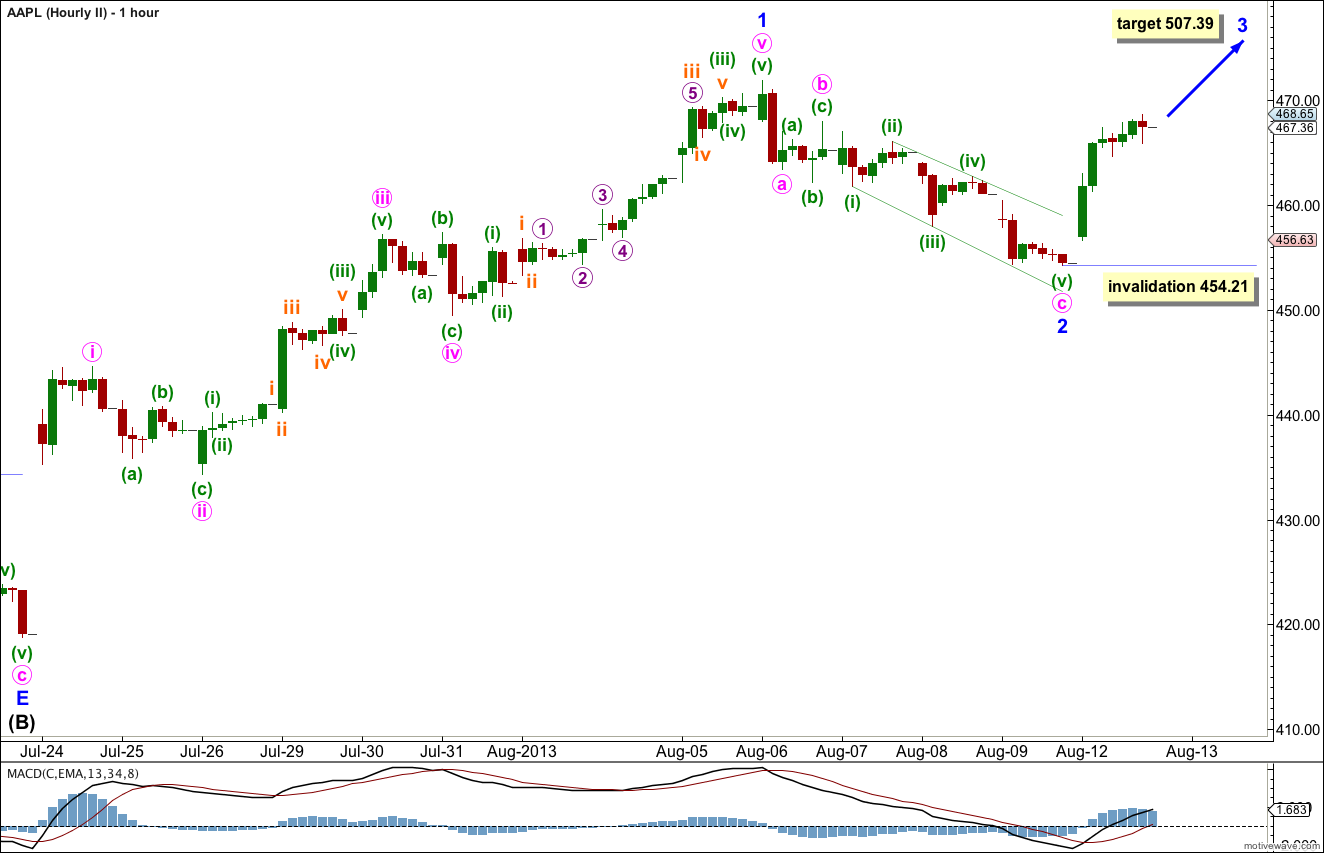Last week I provided a reanalysis of AAPL with monthly and weekly charts. After considering the two monthly wave counts I had last week I have decided that despite slightly worse Fibonacci ratios the second wave count which uses a semi-log scale on the monthly chart has the better look and fit.
Click on the charts below to enlarge.
If the monthly chart is viewed on a semi-log scale then recent downwards movement looks proportional to cycle wave II and it may be cycle wave IV.
On a semi-log scale there is no trend channel breach. The channel is drawn from the highs of cycle waves I to III, a parallel copy is placed upon the low of cycle wave II. Cycle wave IV may find support at the lower edge of this channel.
There is no Fibonacci ratio between cycle waves III and I.
Ratios within cycle wave III are: primary wave 3 is 10.31 longer than 1.618 the length of primary wave 1, and primary wave 5 is 8.86 short of 2.618 the length of primary wave 1.
Ratios within primary wave 3 are: intermediate wave (3) is 9.98 short of 2.618 the length of intermediate wave (3), and intermediate wave (5) has no Fibonacci ratio to intermediate waves (3) or (1).
Ratios within intermediate wave (3) of primary wave 3 are: minor wave 3 is just 0.29 short of 1.618 the length of minor wave 1, and minor wave 5 has no Fibonacci ratio to either of minor waves 3 or 1.
Ratios within primary wave 5 are: intermediate wave (3) has no Fibonacci ratio to intermediate wave (1), and intermediate wave (5) is 6.81 short of 2.618 the length of intermediate wave (1).
If a cycle degree fourth wave correction is unfolding then it is unlikely to be over in just 7 months at the low labeled here primary wave W. The first zigzag is completed, and because of the brevity and shallow correction a second zigzag should be expected.
At the low labeled primary wave W this downwards wave subdivides perfectly as a three wave zigzag. Because a new low was made after this zigzag was completed cycle wave IV cannot be over there, it must be continuing.
At cycle degree the structure unfolding may be a double zigzag, double combination or a flat (which would be labeled A-B-C instead of W-X-Y).
If this structure is an unfolding flat correction then primary wave B (labeled here as primary wave X) would need to reach up to a minimum of 90% the length of primary wave A at 676. Because this would give the flat correction that is unfolding at primary wave degree an odd look this is unlikely. What would have a more typical look is only a little more upwards movement, or none, and for the next corrective structure downwards to unfold at primary wave degree as a zigzag making cycle wave IV a double zigzag.
At this stage primary wave X is a flat correction because intermediate wave (A) within it subdivides as a three wave zigzag, intermediate wave (B) is a corrective structure and is just over 100% the length of intermediate wave (A). So far intermediate wave (C) subdivides nicely as a five wave impulse and is just 2.23 longer than equality with intermediate wave (A). It may be over here, and if it is this would be a regular flat correction.
I have three hourly wave counts for you this week. I do not favour either one.
Hourly Wave Count I.
So far there is a clear five wave structure upwards from the end of the triangle for intermediate wave (B). This may be minor wave 1 within intermediate wave (C) which must be unfolding as an impulse.
Ratios within minor wave 1 are: there is no Fibonacci ratio between minute waves iii and i, and minute wave v is just 0.35 short of equality with minute wave iii.
Within minute wave ii there is no Fibonacci ratio between minuette waves (a) and (c).
Ratios within minute wave iii are: there is no Fibonacci ratio between minuette waves (iii) and (i), and minuette wave (v) is 0.15 longer than 1.618 the length of minuette wave (i).
Within minute wave iv there is no Fibonacci ratio between minuette waves (a) and (c).
Ratios within minute wave v are: there are no Fibonacci ratios between minuette waves (i), (iii) and (v).
Ratios within minuette wave (iii) of minute wave v are: subminuette wave iii is 0.47 longer than 2.618 the length of subminuette wave i, and subminuette wave v is 0.30 longer than 0.236 the length of subminuette wave iii.
Within minor wave 2 this structure may be an incomplete flat correction which requires minute wave b to reach a minimum of 90% the length of minute wave a. This would be achieved at 470.12.
Alternatively, if price does not reach 470.12 and moves lower below 454.21 it is possible that minor wave 2 is continuing as a double combination or double zigzag.
Within both a flat correction and a double the upwards wave (which would be labeled wave B within a flat and wave X within a double) may make a new price extreme beyond the start of the correction. For this reason there is no upper invalidation point for the structure of minor wave 2. What would invalidate this wave count to the upside is a clear five wave impulse upwards.
Minor wave 2 may not move beyond the start of minor wave 1. This wave count is invalidated with movement below 418.71.
Hourly Wave Count II.
If price remains above 454.21 and we see a clear five wave structure upwards unfold then it is likely to be the beginning of a third wave.
At 507.39 minor wave 3 would reach equality with minor wave 1. Because minor wave 2 is a shallow 33% correction of minor wave 1 this would be a likely relationship between minor waves 3 and 1.
Within minor wave 3 no second wave correction may move beyond the start of the first wave. This wave count is invalidated with movement below 454.21.
Hourly Wave Count III.
It is possible that primary wave X is a completed regular flat correction.
If this structure is over then we may have begun a new downwards trend which should last weeks to months.
The first structure unfolding downwards may be a leading diagonal because the first wave downwards is a zigzag. It is difficult to see this downwards wave as a five.
A leading diagonal in a first wave position is possible, but it has a lower probability than an impulse for the first wave. For this reason I need to consider hourly wave counts I and II above.
If primary wave X is complete then within it intermediate waves (A) and (C) are just 2.23 off equality.
Within the leading diagonal minuette wave (ii) may not move beyond the start of minuette wave (i). This wave count is invalidated with movement above 471.89.





